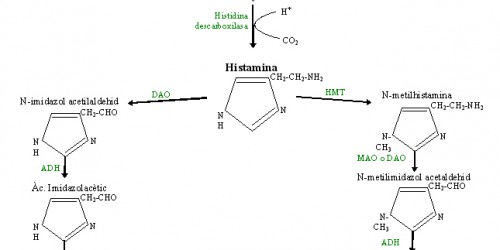More than a year ago I wrote the first article about DiAmino Oxidase enzyme deficiency but I think I should also talk about what histamine is, as it is as important as DAO enzyme.
Histamine is a molecule which derives from an essential amino acid called histidine and it is produced from decarboxylation thanks to L-histidine decarboxylase enzyme. It’s a biogenic amine, from the aromatic amines group, with many cell physiological functions. Biologic amines are basic organic nitrogen compounds, with low molecular weight, which have in common the presence of an amino group and a biological origin. Inside the aromatic amines group we can also find tyramine, β-phenylethylamine, tryptamine and serotonin.
Histamine has many physiological and pathophysiological functions: it is involved in the regulation of local circulation, in capilar hypermeability, in the contraction and relaxation of smooth muscles and blood vessels, in the secretion of hydrochloric acid in the stomach, in immediate hypersensitivity responses in allergic processes, in inflammatory processes as part of an immune response to foreign pathogens, in the healing of tissues and it has also been identified as a neurotransmitter in the central nervous system.
Therefore, knowing all the functions it develops, essential for the proper functioning of many metabolic processes, it’s not strange that histamine is found in more or less significant amounts in many food, with both animal and vegetable origin. It is because of this reason that it is important to know how to control the adverse effects caused by its accumulation in our body.



